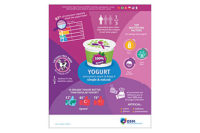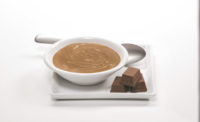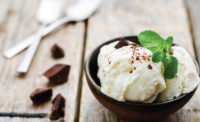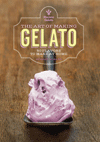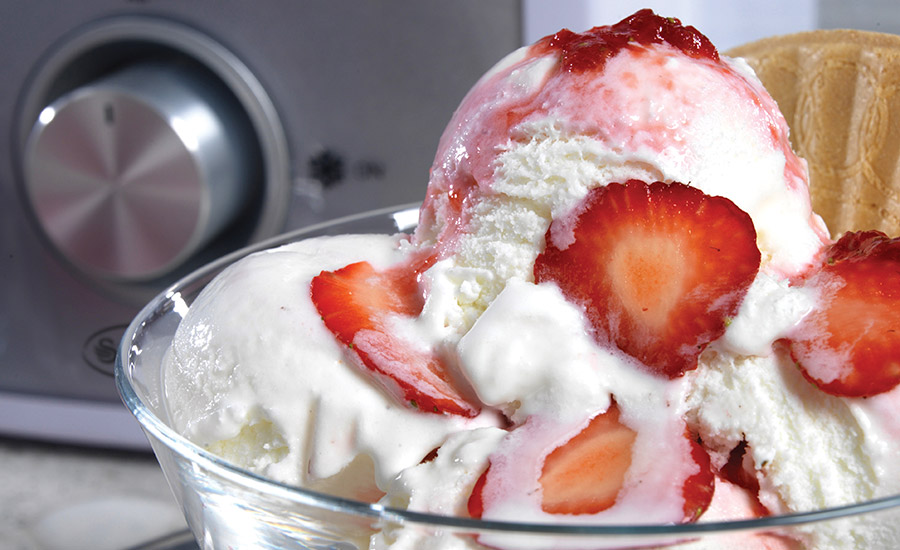Gelato gives consumers simple ingredients, with indulgence

Photo courtesy of Angelo Gelato Italiano

Angelo Gelato Italiano is known for its unique and custom flavor creations. Some of its gelato concoctions include chocolate bacon, honey lavender, caramel swirl with cheese popcorn, jalapeno, corn on the cob, Guinness beer, and sparkling Champagne. The company produces over 100 different gelato flavors.

Countless gelato companies (including Unilever and G.S. Gelato) have found a healthy appetite among consumers for this sumptuous specialty. Photo courtesy of G.S. Gelato.

Several companies have gotten into the gelato market or launched new flavors over the last two years. Häagen-Dazs launched its gelato line in 2013, and Unilever’s Talenti added a slew of new flavors last summer




When Guido Tremolini and Simona Faroni left Italy for Florida’s Emerald Coast in 1996, they dreamed of bringing classic, Italian-style gelato to the United States. Looking back, it’s clear the odds were stacked against them. It’s not just that they spoke virtually no English, or that their authentic Italian processing equipment didn’t meet the Florida Department of Agriculture’s safety standards (a situation long since rectified).
More daunting was the near-existential question of whether a nation already awash in old-fashioned ice cream had any room left for its foreign cousin. But as Faroni is fond of noting, it’s not as if America didn’t have plenty of coffee to go around before espresso showed up, and that didn’t hamper the blockbuster beverage’s rise. More than two decades on, the husband-and-wife owners of G.S. Gelato & Desserts, Fort Walton Beach, Fla., are still at it. (Read more about them in the May 2013 Dairy Foods.)
Countless other gelato companies (including ice cream giant Unilever) have found a healthy appetite among consumers for this sumptuous specialty. In fact, gelato’s high profile can teach the dairy industry as a whole a lot about what’s driving demand for frozen dairy desserts, and how processors can capture some of it for themselves.
Secret to success
Angelo Quercia also had faith that gelato would catch on with Americans. He is vice president of Angelo Gelato Italiano in the Chicago suburb of Bensenville.
“Yes, I placed a bet on gelato,” he said. “I’ve been making it for 30 years, and it’s still very popular. In my mind, I see no disadvantages. Gelato is a great dessert.”
Backing up those claims of popularity is Beth Bloom, a food and drink analyst at market researcher Mintel. Gelato has “driven growth in the [frozen treat] category in recent years,” its “higher price point” notwithstanding, she wrote in a report. Gelato sales went from $11 million in 2009 to approximately $214 million in 2014, per Mintel data, even as U.S. retail sales of ice cream and frozen novelties overall suffered an inflation-adjusted dip of 3% over the same period.
Never underestimate the indulgence factor
What is giving gelato its spark? Tom Kelman, president and owner of Kelman Consulting, a Marshall, Wis.-based food consulting firm specializing in ice cream and frozen novelties, has a few theories. For one, he said, consumers perceive gelato as “an even more indulgent product than our current domestic ice cream.”
Among the changes to hit the category is the profusion of products labeled “low-fat” or “reduced-fat,” “frozen dairy dessert” and “frozen yogurt.” Consumers choosing such products “may not even be aware that they’re purchasing a product that’s not ice cream,” noted Kelman, who also works with the Frozen Dessert Center at the University of Wisconsin, Madison. Further, as manufacturers continue to push the envelope vis-à-vis overrun — the amount of air incorporated into the ice cream mix as it freezes — the trend has been toward a fluffier, less-dense product with a loosened body and texture, he said.
Then there’s the growing reliance — in both mixes and in variegates — on alternative sweeteners, solids, stabilizers and emulsifiers that not only break from ice cream’s tradition of milk, cream, sucrose, skim milk solids and possibly egg yolks, but that “make ingredient legends extremely complex and lengthy,” Kelman said — all at a time when consumers are “increasingly turning to simpler ingredient legends and perceived ‘more-wholesome’ or ‘natural’ products while demanding indulgent flavors.”
Name of the game
Enter gelato, which, “in its pure sense,” Kelman said, is “a product with only a few ingredients and often unique and high-intensity flavors that offer the consumer an indulgent treat.” So he sees gelato’s relevance as stemming less from a specific craving for the dessert itself than from consumers’ desire for “an ice-cream product that offers the indulgence, wholesome or clean-label appeal that comes from treating oneself to a special treat.”
And gelato is a special treat.
“With very decadent offerings and international flair, gelato has enabled manufacturers to command a very premium price,” said Alan Owen, director of marketing at Sensient Sweet Flavors, Hoffman Estates, Ill. “Yet it’s still an affordable indulgence that reflects a progressive, upscale lifestyle.”
How manufacturers convey lifestyle and flair in a frozen-dessert formulation — all while satisfying consumers’ taste and texture cravings — is the name of the gelato game. But the Food and Drug Administration’s Code of Federal Regulations (CFR) provides few ground rules for how to play it. Without a specific gelato standard of identity, processors must thus “be mindful of their mix formulations so as not to produce a product that falls into the 20%-dairy-solids ice-cream identity-standard category,” Kelman advised.
The better bet, said Janae Morris, marketing assistant at PreGel America, Concord, N.C., is to follow Italian tradition. Gelato — which means “frozen” in Italian — traditionally has less air churned into its mixture as overrun than American ice cream, and at 50% overrun or less “creates a smoother, creamier texture” and a greater density and richness that belie gelato’s lower milk solids and fat content.
Indeed, it may surprise consumers to learn that there’s actually less butterfat in gelato than in ice cream, with the former topping out at approximately 9%, Morris said, while the latter can reach up to 23%. With less butterfat, “gelato exhibits a warmer eating temperature due to the reduction of ice crystals that can freeze the palate, resulting in less intense flavor,” she added. The upshot: “Gelato offers a richer flavor and more luxurious mouthfeel than traditional ice cream, with more nutritional integrity.”
Granted, nutritional integrity may not top the list of priorities driving consumers to gelato. But a certain wholesome halo does hover over the dessert. And that balance of integrity and indulgence, Kelman said, attracts many consumers who “are increasingly concerned about their health and nutrition,” but who also “want to have a decadent dessert choice.”
Faroni has witnessed this phenomenon firsthand.
“We’re experiencing consumer choices oriented toward indulgence and decadence, along with more awareness and knowledge about the health attributes of specific products,” she said. The two demands, she believes, aren’t so much mutually exclusive as mutually compatible. “The fact that our gelato has no HFCS [high-fructose corn syrup], is non-GMO, uses natural flavors only, has real fruit in it,” she said, “are all certainly wonderful attributes that are associated with consumer choices.”
“‘Clean label’ is the new ‘all natural,’” she said. And to make a great gelato you do not need to add a lot of ingredients. It’s the balance and harmony amongst them that’s critical.”
Balancing performance with perception
Consider sweetener choice. Gelato requires a high sugar content to achieve its “soft scoopable texture,” Kelman said, and the most common sweeteners used are sucrose and dextrose. The former provides a clean sweetness that doesn’t interfere with the flavor of the finished product, while also depressing the mix’s freezing point to improve finished-product texture. Dextrose, meanwhile, supplies body and texture while further depressing freezing point for smoothness, creaminess and scoopability. Even honey, maple syrup or brown sugar will work, provided that use levels “only provide sweetness or assist in promoting the desired characterizing flavor profile” — as opposed to overpowering it — Kelman cautioned.
For manufacturers pursuing both a cleaner label and sugar reduction, Thom King, president of Steviva Ingredients, Portland, Ore., suggested using a blend of the mildly sweet polyol erythritol plus the natural, high-intensity sweetener stevia.
For gelato makers, the heavier lift is “determining how to stabilize and emulsify their mix so that their end product can withstand distribution while maintaining its ‘clean’ label,” Kelman said. The stabilizing and emulsifying ingredients that let this happen are workhorses in frozen dairy formulations, protecting against heat shock, improving stability and enhancing the finished product’s body and texture. But they don’t always look great on a label. So it’s natural to ask: Does gelato really need them?
It depends, said Donna Klockeman, senior principal food scientist for TIC Gums, White Marsh, Md., “The differences in texturizing systems for gelato compared to regular ice cream find their roots in the combination of differences between the two desserts.”
That would be their total solids, respective sweetener systems, differing package sizes, serving temperatures, desired overrun, et cetera. An effective system, she said, will account for these differences and “balance the need for emulsification — combining fat level with overrun — with mix thickening, melting and eating textures and threats to freeze/thaw stability.”
For instance, with gelato being packaged in smaller containers, it faces greater freeze-thaw stress than many mass-market ice creams. What’s more, the lower overrun and warmer serving temperatures “affect both the need for emulsifiers and the melting characteristics,” Klockeman added. Hydrocolloids are go-to choices for bolstering freeze-thaw stability and controlling melting and eating textures, and “using a system with one or two ingredients can produce high-quality gelato following ‘clean,’ ‘simple,’ and ‘premium’ labeling requirement,” she said.
Then again, if a gelato is produced in house for same-day consumption, “the manufacturer may choose not to use any” stabilizers or texturizers,” Kelman said. Other important considerations include production and freezing methods, as gelato can be a production challenge depending on the base formulation and added flavors.
“Many of the bases used to flavor gelato do not mix well in many of the flavor tanks that have been used in the past,” Kelman said, compelling processors to take extra care incorporating them fully into the mix. “Products may require multiple ingredients that have to be added to the flavor tanks in varying amounts,” he said, and the freezing process itself may involve different procedures and “lead to differences in gallons per hour for the manufacturer, and thus a different costing consideration.”
In any case, Morris pointed out that gelato is still often mixed and batch-frozen in small quantities for display in 2.5- to 5-liter pans.
But even as traditions change, gelato makers continue to prize their artisanal legacy. “It means a lot for our product to be called artisanal and premium,” Quercia said. “I learned to make gelato from my father and brought that tradition from the Old Country to America. Everything I put into my gelato is fresh and definitely premium, and it’s made daily at our facility.”
Faroni shares his sentiment. “I come from Italy, where the word ‘artisan’ is taken very seriously,” she said. “That applies to food, arts, crafts and professions.”
And to gelato, which, she has no doubt, “is here to stay.”
Looking for a reprint of this article?
From high-res PDFs to custom plaques, order your copy today!



